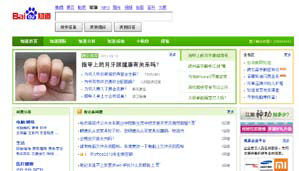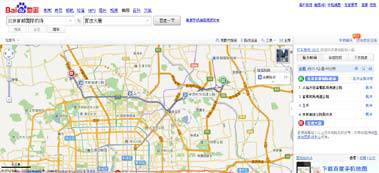As computer networking technology rapidly advances, devices with Internet capability are becoming increasingly commonplace and a growing number of content and services are surfacing on the World Wide Web. Given that such content and services are presented to users in the form of web pages, the design of a web page is critical to help differentiate between one company’s offerings from those of its competitors, and to attract users better. These requirements are causing Internet companies to utilize significant manpower and resources to develop innovative and better web pages. For example, the fruits of Baidu’s laborious efforts can be seen in its numerous online offerings, such as Baidu’s web page search, Tieba, and its Baidu Music product.

To encourage innovation, most countries provide various intellectual property protection mechanisms to protect innovators against copycats and free riders, which in turn should lead to increased consumer choices and better products. These legal protections were originally created to protect physical product innovations, and have gradually evolved as society advances into different technological ages to protect intangible innovations. However, intellectual property protection mechanisms are often unable to keep up with the rapid development of technology, which presents challenges to innovators who wish to protect their inventions, especially when such protections are applied to protect innovations in cutting-edge industries, such as the Internet. For example, because web pages and their source codes are readily available to viewers. Innovative features therein can be easily copied and used in others’ web pages, free riding on the innovator’s creative efforts. This article addresses how innovators can adopt strategies through the use of different types of intellectual property protection mechanisms to protect innovations on web pages.
A web page is a document that is suitable for the World Wide Web and through which users can access using a web browser connected to the Internet, and is then displayed on an electronic screen. Figure 1 is a screenshot of the main page of Baidu Knows, a search-based interactive knowledge sharing platform. Most web pages render contents (e.g. display text and images, play sound and video clips) to their viewers (contents) and / or perform functions (e.g. calculate a formula, plan a road trip) (functions), which often involve user interaction (e.g. type in parameter values, select destination). Figure 2 is a screenshot of Baidu Maps, showing a road trip. Internet companies have expended significant efforts to improve their web pages with respect to contents and functions to enhance user experience. The resulting innovations should be and are able to be protected via certain intellectual property protection mechanisms.
The design of a web page’s appearance (e.g. the layout of the web page, the arrangement and visual characteristics of the contents) may be protected as an industrial design under the Paris Convention for the Protection of Industrial Property. Even though China’s design patent law does not cover web page designs specifically because they are "flickering or visible only under specific conditions"(provided in SIPO 2010 Guidelines, Part 1, Chapter 3, Section 7.2), or "shown when the product is electrified"( provided in SIPO 2010 Guidelines, Part 1, Chapter 3, Section 7.4(11)), United States design patent law considers a Graphical User Interface (GUI) to be a patentable subject matter and provides patent protection. In fact, Google and Baidu, the world’s two largest search engine companies, have both applied for patent protection for each of their homepages in the United States. A web page design can also be protected via various "design laws" established in compliance with the Paris Convention in Europe and in countries such as Japan and South Korea.

The original contents of a web page as well as their original arrangement (e.g. the layout of the web page) are protectable under the copyright law. Despite the fact that China’s Copyright Law does not specifically address web page copyright protection, recent court rulings consistently interpret the copyright law to cover web page content and design. For example, the Beijing Chuanglian Telecommunication Company v. Beijing Huimeng International Business Consultant is one such case. Web page designs are also protected under the copyright laws of other major jurisdictions, including the United States and Europe.
A web page is typically expressed in HyperText Markup Language (HTML), and HTML expressions can be protected under copyright law. Countries such as China and the United States have registration programs in place for copyright owners to register their computer software. Internet companies are able to obtain copyright protection for their web p a g e HTML c o d e b y registering with the authorized governmental agencies.
Contents of a web page bearing trademarks may be entitled to trademark protection. Also, the overall "look and feel" of a web page can be protected under unfair competition laws in countries like China, and under trade dress regulations in countries such as the United States.
Web pages created using HTML5 and JavaScript can provide viewers with services ranging from online calculators to word processors. Such web pages are often called web applications (or web APPs), suggesting that these web pages are in some way equivalent to the native applications (software programs installed in the underlying computer system), blurring the boundary between web pages and software programs. In China, innovations in software programs can be protected as technical solutions through the use of invention patents. Other jurisdictions, such as the United States, Europe, and Japan, similarly afford software inventions patent protections. Innovations in Functions of web pages and particularly web APPs should be similarly protectable via patents. Innovations in software programs are commonly protected either as hardware products (e.g. software programs integrated with hardware components) or as business methods practicing the innovations. Because web APPs are typically retrieved from the Internet and rendered in web browsers, their reliance on specific hardware components is much less compared to native applications. For example, Baidu’s web APPs can be executed across different computer platforms, such as Windows, iOS, and Android, demonstrating that innovations in web APPs should more properly be protected as methods instead of products.
In addition, as computer network bandwidth capacity increases and more users rely on Smartphones to access the Internet, web APPs are utilizing increasing amounts of resources in remote servers to address users’ needs. For example, as an important part of Baidu’s open cloud computing platform strategy, an increasing amount of web APPs affiliated with Baidu utilize the computing power, personal storage, and rich user data provided by Baidu’s cloud platform to deliver satisfactory results to Baidu’s users. Innovations in the cloud and the interactions between web pages and the cloud can also be protected via patents.
Furthermore, web pages are often created on-the-fly on web servers based on user requests. Innovations in web page creation mechanisms can be protected in a manner similar to the software patent protection.
As mentioned above, web pages can be protected through different types of intellectual property protection mechanisms. These mechanisms provide different protection scopes; for example, copyright protection is easy to acquire (no registration is required) and protects original expressions, which may prevent competitors from using the same expressions but cannot stop them from using other equivalent expressions. Patent protection, on the other hand, is hard to obtain (requires time-consuming application process), and depending on where the infringing acts take place (e.g. on web servers or in the cloud), it may be hard to prove infringement of patents protecting innovations.
In order to effectively protect their proprietary web pages from potential infringers, Internet companies should carefully assess each type of intellectual property protection mechanism in view of their products, competitors, and markets. A good intellectual property protection strategy typically involves a combination of various intellectual property protection mechanisms specifically tailored to a company’s needs, and evolves over time based on the company’s commercial needs and the overall intellectual property protection system.


